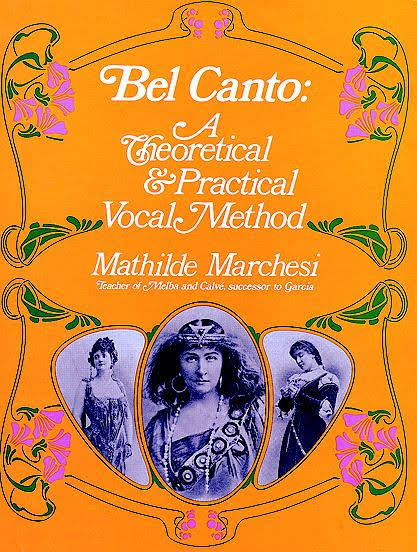
For any of you vocal coaches out there who feel the old school still has lots to teach us then Mathilde Marchesi’s book A Theoretical and Practical Vocal Method (Bel Canto) is a must read. For those of you that don’t know Mathilde Marchesi was one of Manuel Garcia’s (one of the worlds best vocal coaches) students.
After an opera career, Marchesi retired to teach other great classical singers like Dame Nellie Melba, Emma Earnes and her own daughter Blanche Marchesi who herself had a great opera singing career then retired to become a great singing teacher (vocal coach). She taught some of the greatest classical singers of the next generation.
What I love about reading these older books is the wisdom in the pages. Make sure to read them several times to get all those little-hidden gems!
I have found as I practised these exercises along with the instruction that every time I would get a little more insight into the meaning of the text. As my mind and body align.
Mathilde Marchesi Approach to Singing
Mathilde believed (like I do very strongly) that singing should be a natural response to the will of singing. That if the posture is good the natural response of the breathing will be there.
I find books today are far less committed to making comments like this. The stuff that gives you insight into the singing mindset is often missed out. If you disagree and have read a book of late that does cover this then I would love to know about it, so please drop me an e-mail!
To smile or not to smile when singing?
Again another point that I have had to prove to my students over and over. The ones that come in with throat tension and facial tension when they have been taught the smiling face setup for singing. Smile when you sing. Granted that often the student does it with to much tension in the face but even when they don’t the sound is still a little unnatural sounding to my ears anyway.
So great to read that she is also not a fan of this style.
Other areas covered in the book
In Mathilde’s “Practical guide for students” section she covers the following areas:
Attitude of the singer,
The mouth
Respiration,
Attack – coup de glotte
Registers of the female voice,
Method of study,
Analysis,
Style.
I have already covered the first two areas that I felt stuck out for me. There are two other sections that I found an interesting read.
The section on the attack of the sound (coup de glotte) boy o boy has there been a lot of discusion about this topic, originally this term was first mentioned by Manuel Garcia when he was asked to describe how a student should start a sound. Mathilde Marchesi gives her directions on how to do this onset correctly.
Registers of the female voice
The other one is her opinion on the female voice and the registers. Mathilde taught for 42 years and in that time only taught females to sing. I believe this and the mindset she had which you can glean from reading this book makes her a real authority on registration.
The Marchesi vocal method
After the practical guide (which should be read carefully with regular pauses for thought) the book moves onto the “first part” of the Marchesi vocal method. This section starts with exercises to help develop the voice and prepare it for the second part.
It starts with the good old onset which I am always amazed at how few of my students have studied when they come to me from other vocal coaches!
Here is a list of the first part sections:
Emission of the Voice,
Chromatic Slur,
Diatonic Slur,
Portamento,
Scales,
Exercises for blending the Registers,
Exercises on two notes,
Exercises on three notes,
Exercises on four notes,
Exercises on six notes,
Exercises on eight notes,
Chromatic Scales,
Minor Scales,
Exercises on Flexibility,
Varied Scales,
Repeated Notes,
Triplets,
Arpeggi,
Messa di Voce (Swelled Sounds),
Appoggiatura – Acciaccatura (crushed Notes) – Mordente,
The Turn,
The Shake (Trill),
Shakes by Thirds,
All these sections are peppered with Mathilde’s insights and instructions.
Development of the Exercises in the Form of Vocalises
The second section of Marchesi’s Vocal Method covers:
Attack,
Portamento,
Sostenuto,
Diatonic Scales,
Dotted Diatonic Scales,
Minor Scale,
Major and Minor Scales alternating,
Chromatic Scales,
Repeated Notes,
Triplets,
Arpeggi,
Appoggiatura and Acciaccatura (Grace Notes),
Mordente and Turns,
Syncopation,
Long Intervals,
Staccato, Mezzo Staccato and Accented Notes,
Shakes,
This book is well worth a read. The insights it gives into a very gifted singing teacher from a time when vocal coaches were not so guarded about their techniques.
If you are a vocal coach or vocal method nerd (yes that’s me on both counts) then you should have no problems with reading this book.
If you are new to singing and looking for a starter book, this is probably not for you as it does cover topics that assume that you already talk the talk and walk the walk. If you know what all the topics from the list above mean, then you will be fine. Otherwise, it might be best to start with something a little easier or expect to do a little research until you become familer with these terms.
Summary
Great read, instruction and insight into Mathilde Marchesi’s Vocal Method. If you are interested in getting this book then here is the link for it.
